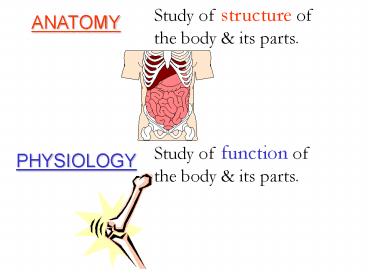Functions of the Cell Membrane - PowerPoint PPT Presentation
1 / 40
Title:
Functions of the Cell Membrane
Description:
Study of structure of the body & its parts. ANATOMY Study of function of the body & its parts. PHYSIOLOGY ENZYMES ENZYMES INORGANIC MOLECULES VERSUS ORGANIC MOLECULES ... – PowerPoint PPT presentation
Number of Views:45
Avg rating:3.0/5.0
Title: Functions of the Cell Membrane
1
ANATOMY
PHYSIOLOGY
2
PATHOPHYSIOLOGY
CELL
Basic unit of all living things
TISSUE
Ex Muscle tissue nervous tissue
3
ORGAN
A group of tissues that perform a specific
function
A group of organs or structures that perform a
specific function
SYSTEM
4
HOMEOSTASIS
METABOLISM
Anabolism
Catabolism
5
NEGATIVE FEEDBACK
Pancreas stops producing Insulin
6
Anatomical position
7
(No Transcript)
8
(No Transcript)
9
(No Transcript)
10
BODY CAVITIES
11
MEDIAL
LATERAL
SUPERIOR
DISTAL
12
MIDSAGITTAL
Thoracic
Abdominal
Pelvic
Diaphragm
Negative Feedback
The System that integrates coordinates
activities in the body is the
Nervous System
13
CELL
-- called semi-permeable
14
ENZYMES
The reverse of this process would occurs with the
breakdown of a substance
15
CYTOPLASM
-- Control center
16
(No Transcript)
17
Functions of Cell Organelles
Synthesis of carbohydrates
Site of aerobic cell respiration
-- ATP production
18
Flagellum
Sweep material across the cell surface.
Synthesis of lipids
Site of protein synthesis
19
WATER
Water outside the cell -- Extracellular
20
Fluid within the cell -- Intracellular
DIFFUSION
21
OSMOSIS
RELATIONSHIP BETWEEN SOLUTE AND WATER
CONCENTRATION IN A SOLUTION
22
Isotonic
Hypotonic
Hypertonic
23
Hypotonic
Name the type of solution cell has been placed in
Isotonic
Hypertonic
24
Filtration
Active Transport
Requires energy -- ATP
25
Phagocytosis
-- Cell Eating
Pinocytosis
-- Cell Drinking
26
TISSUES
Also Classified as a. Simple
b. Stratified
c. Pseudostratified
27
NERVOUS TISSUE --- NEURON
28
MEMBRANES
Epithelial
2. Serous Membranes
--Lines closed cavities
a. Pleural
b. Pericardium
c. Peritoneum
29
Visceral -- refers to organs
Parietal -- refers to linings of cavities
Connective
1. Fascial Membrane
2. Skeletal Membrane
-- covers bone cartilage
3. Synovial
30
Chemistry
ATOM
Element
--made up of one type of atom
--105 different chemical elements
--can be a gas, liquid, or solid
31
Elements are identified by
Name
Symbol
Atomic Number
-- determined by of protons
Atomic Weight
Isotope
32
Molecule
-- when two or more atoms unite
-- may be alike (O2)
Compound
Ex. H2O HCL NaCl
Ionic Bonding
-- transfer of electrons
-- also called an Electrolyte
33
Covalent Bonding
H2O
34
INORGANIC MOLECULES VERSUS
ORGANIC MOLECULES
35
PROTEIN
Amino Acids
Familiar roles of Protein
- Building new body tissue
- Repairing body tissue
--Some are Essential
- Regulating water balance
- Regulating acid-base balance
- Providing energy
- Providing resistance to disease
36
FATS
-- some fatty acids are Essential
37
pH SCALE
38
Buffer System
39
If the pH of the blood rises -- carbonic acid
(H2CO3) dissociates to release H (Hydrogen)
---- H HCO3- (bicarbonate ion)
If the pH of the blood lowers -- the bicarbonate
ion (HCO3-) combines with the excess Hydrogen
ions (H) to form Carbonic Acid (H2CO3)
40
Ways to increase the Acidity of the Blood
1. Increase number of free-floating Hydrogen
ions.
3. Decrease the amount of Bicarbonate in the
blood.
Way to increase the Alkalinity of the Blood
1. Decrease number of free-floating Hydrogen
Ions.
3. Increase the amount of Bicarbonate in the
blood.































